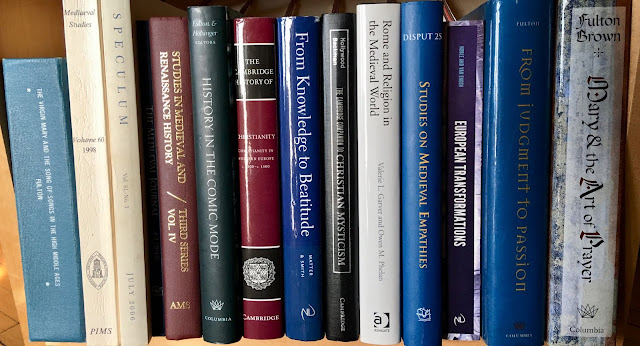Maege Mormont and the Threat of Art
I do not watch Game of Thrones. I have no idea who this character is, whether I would like to be compared with her or not.
I learn from A Wiki of Ice and Fire that her name is Maege Mormont, the Lady of Bear Island, and that she is “a short, stout, grey-haired woman, and a fierce warrior.”
She dresses in patched ringmail, and her favored weapon is a spiked mace. She is dedicated to the old gods, and loyal to House Stark. According to her brother, Jeor, she is stubborn, short-tempered, and willful.Apparently, she carries the title of House Mormont because her brother’s only heir is an outlaw, while she herself has five daughters of mysterious paternity. Perhaps she changes shape and mates with a bear?
Well, I am a bear in one of my guises, but I don’t have any daughters. And thanks to Milo’s fat shaming, I am not exactly stout. But grey-haired? Check. Fierce warrior? I prefer “hot and happy,” but okay. You could say I am dedicated to the Old God—the God of the Psalms, the one modernity rejected as too unsophisticated and replaced with the trinity of Science, Reason, and Humanism. And, of course, I am loyal to House Milo. According to my brother...check, check, check! (Waves at beloved younger sibling! Go, read his blog. He knows all about spiritual warfare.)
So, we’ll go there. I am a Bear Lady of a Certain Age.
 This is not what my colleagues in medieval studies saw last autumn when Milo’s staff writer used this image to illustrate her article about my blogpost on the on-going controversy in our field over what to do about the use of medieval imagery by certain white supremacist groups, including some of those interviewed by Milo and Allum Bokhari for their piece in Breitbart about the alt-right. (Got all that? Good.)
This is not what my colleagues in medieval studies saw last autumn when Milo’s staff writer used this image to illustrate her article about my blogpost on the on-going controversy in our field over what to do about the use of medieval imagery by certain white supremacist groups, including some of those interviewed by Milo and Allum Bokhari for their piece in Breitbart about the alt-right. (Got all that? Good.)As they put it in the Open Letter that 1500 or so academics signed against me and sent to my provost, executive vice provost, and dean, my medievalist colleagues were deeply concerned that a) I do not argue on the basis of critical race theory when I suggest that the best way to counter the arguments of the white supremacists is to “learn some f*cking medieval Western European Christian history, including the historiography of our field” (I think it was the “f*cking” that got them; funny, I have been listening to them talk dirty about Christianity for decades); b) I used an image of Professor Kim that I found on the Internet with one of her interviews to illustrate her argument that she does not need to signal to her students that she is not a white supremacist while all those of us who are white do (It was my fellow white colleagues to whom I directed my instructions to learn some “f*cking...history,” not Professor Kim); and c) I tagged Milo in my Facebook share of my blogpost, thus “[exposing] Professor Kim to one of the most racially violent contingents currently operating.” (Seriously? Does none of these people ever watch Milo’s videos? You’d think as scholars they would want to do the primary research.)
But it was the article on Dangerous that convinced my colleagues that I had put Professor Kim in the greatest danger of “virtual harassment or actual harm.” In their words:
Indeed, one day after Professor Fulton Brown’s post appeared, Professor Kim began receiving hate mail [proof of which Professor Kim has yet to publish], and Yiannopoulos himself [Milo was not the author; it was one of his staff writers] created a post for his followers describing Professor Kim as having been “beat[en] down” by Professor Fulton Brown and her sword.
That post is not a mere Facebook folly. It contains an image from “Game of Thrones” of a female figure holding a metal-spiked club. Her weapon bears resemblance to the barbed-wire-wrapped bat used to kill an Asian-American character in “The Walking Dead” by bashing in his head. A post by another social media user accompanies the picture of Professor Kim with an assertion that Professor Fulton Brown “gets medieval” on her; the violent meaning of this familiar phrase from “Pulp Fiction” is well known.
This country’s sense of license to inflict violence upon people of color is considerable; we do not deem it unreasonable to fear for our colleague’s safety as a result of your colleague’s actions.The article at Dangerous no longer shows the images, but you can read what Milo’s staff writer penned. I spoke with her on the phone after the article posted—there were some corrections that I wanted her to make to my name—and she told me about the classes she had taken in college on the Bible and how much she admired my work. Based on the account of her piece given in the Open Letter—that, according to the headline, I had “beaten down” Professor Kim “with facts and fury”—the reader is primed to expect the worst. This is what the article actually says about my furious facts:
Dr. Fulton Brown dismisses the obvious accusation that she could be a witch (witches make false oaths all the time) and denounces white supremacy, as did the authors of the Bible. While denying accusations of occultism, Dr. Fulton Brown nevertheless refers to “chants, puzzles and references to glass artifacts” to demonstrate that white European Christians do not appear to have been terribly interested in Mary’s identity group orientation, and instead appear interested in the fact she gave birth to the Son of God.
Citing scripture in Latin and English, narratives depicted in stain-glassed windows of medieval Cathedrals in Europe, fellow medieval scholars and chants and liturgy from the era, Dr. Fulton Brown demonstrates that the only person surprised that the Virgin Mary was a dark-skinned Jewess appears to be Dorothy Kim. As all good professors will do, Dr. Fulton Brown then guides Kim through the process of understanding that dark-skinned Jewesses are unlikely to be objects of abiding admiration for either Nazis or white supremacists.Snarky? Well, a bit. But calling down Milo’s fabled Troll Hordes to descend with threats of bodily harm? Give me a break. (News flash: THEY DON’T EXIST.)
How did my colleagues manage to convince themselves that I had done what they claimed? That I had placed Professor Kim in physical danger? My take: it was the image. Look at the way in which they argue in the letter: because Maege Mormont is shown holding a spiked mace, and there is another character in a completely different story world that uses a barbed-wire-wrapped bat to kill an Asian-American character, Milo’s staff writer must have meant to encourage my Facebook followers (the source of “another social media user”) to “get medieval” on Professor Kim.
I shared the image on my own Facebook page, with this explanation:
About that image that Milo’s team used for the article that they did about my blog post... It is Maege Mormont, known as the She-Bear. Get it? “She-Bear,” Fencing Bear...oh, never mind. The picture that they used was done by Emile Denis.Here is what my friends (a.k.a. Random Laypersons) said:
Well the open letter was written to appeal to a constituency that is triggered by the word “Breitbart”. It is no surprise then that they were triggered by an image of a tough, resilient mature woman, no matter its provenance. For a generation of boomer academics, and Gen Y students that do not agree to any distinction between words, imagery, and actual violence, this is unfortunately par for the course.
What kind of medievalist doesn't know the difference between a mace and a baseball bat...geez.
She-Bear is not as lovely as Fencing Bear. But, like the fierce imagery.
Jorah Mormont's aunt. They are among the most steadfast and honorable of the Houses.I have said before that we are living through a crisis of religion. Based on my colleagues’ reaction to the image of the Lady of Bear Island, I would also argue that we are living through a crisis of symbolism and art. Thanks to the Enlightened emphasis of the past 200 years, particularly in academia, on “science, reason, and humanism,” we have utterly lost the capacity to think in metaphor and analogy—the ground on which much religious thinking depends. This, of course, is why Jordan Peterson’s lectures have captured so much attention. It is also the reason, as I keep saying, that I wish he would read my book.
It isn’t the Logos that we have forgotten. It is the Lady—and with her, the real reason that art is so threatening: because, like Milo in his provocative costumes and characters, it points us to God.
See MedievalGate for my continuing adventures as a conservative in academia.






